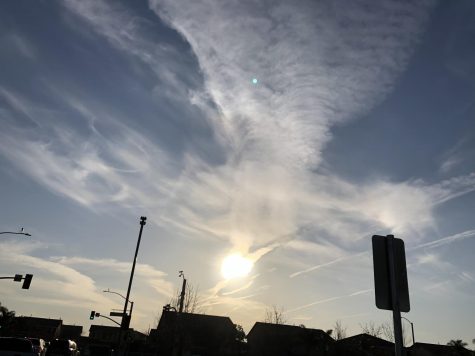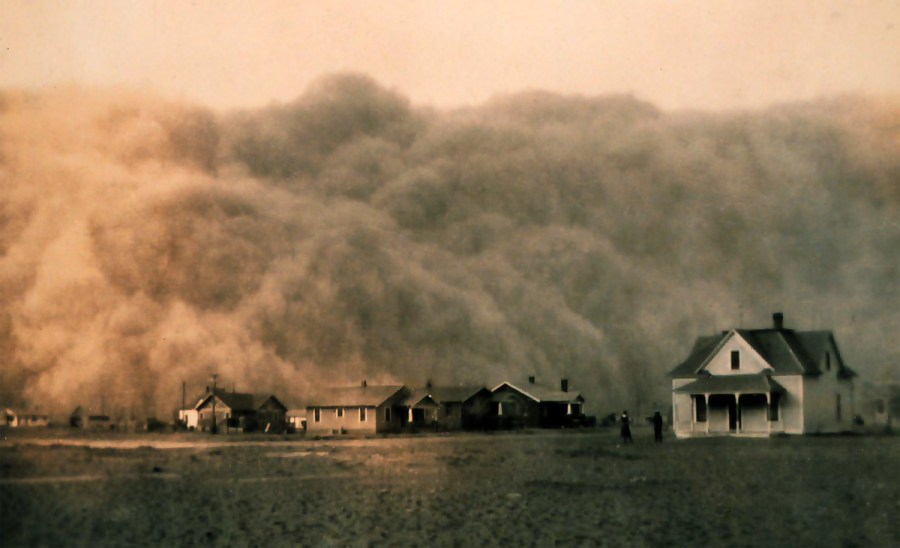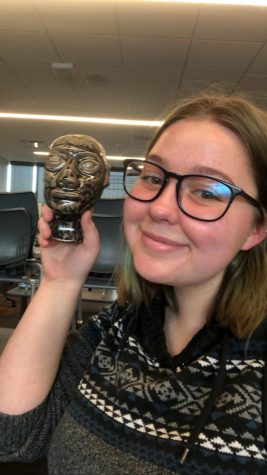The Dust Bowl: Too Big Too Soon
image of dust storm running over a Texas town.
March 6, 2020
A few weeks ago, my history teacher asked the class to dive down into the tragedy of The Dust Bowl. He asked us to debate whether or not a similar tragedy could occur today. The Dust Bowl was a terrible series of dust storms that contributed to The American Great Depression. The geographical location, types of failing crops, and La Nina weather conditions were the beginning of the bowls creation. The failed farms led to a multitude of families losing their source of income, homes, and lives. The Dust Bowl could have been prevented by awareness of the region’s limitations before the farming, but, of course, hindsight is 20/20. When you break down The Dust Bowl into in simplest form, a degradation of land by humans, it is undeniably happening as we read this article.
The Dust Bowl was the name given to the geographical bowl that is located in southeastern Colorado, south-western Kansas, the Oklahoma and Texas panhandle, and northeastern New Mexico. This region was mostly plains of drought resistant prairie grasses. Soon after settling, people began farming this land. The drought resistant grasses were replaced with finicky wheat crops that couldn’t survive the La Nina conditions that include droughts. Benjamin Cook in his study, “Amplification of the North American ‘Dust Bowl’ Drought through Human-Induced Land Degradation”, explains how “with no drought plan and few erosion-control measures in place” the land was subjected to “large-scale crop failures at the initiation of the drought, leaving fields devastated and barren, exposing easily eroded soil to the winds”. This newly exposed soil was the dirt used to create the dust storms that plagued the area. Simply put, the grass held down the dirt when it got windy, but without that support, the wind was able to lift the soil and create the storms.
If we had planted more hardy crops or chose a different way to utilize the region, the drought would have prevailed but the life-threatening dust storms would not. Cook confirms this claim by using “improved simulation of temperature and precipitation anomalies”. He tells how “when more realistic land surface boundary conditions are included, (the test) suggests that land surface feedback from the human-induced land degradation are a necessary ingredient to explain the atypical nature of the Dust Bowl drought” (Cook). The wheat crop was the true failure.
Farms failed and people were forced to leave their homes for fear of the killer dust storms. It caused a human migration that is comparable to the Hurricane Harvey evacuation of ’05. Cities became more crowded from the migration. Jeremiah Murray, ERHS history teacher, explained how “Dust Bowl refugees coming predominately to California were commonly referred to as ‘okies'”. They were met with “hostility and discrimination” because “in times of job scarcity, any new faces competing for those jobs are usually met with that type of hostility. Sadly, not much has changed”. The migration and new struggles introduced by The Bowl made an incredible impact on the media of the time. Some of the most compelling and heart wrenching books I have ever read center on the devastation The Dust Bowl created.
Sadly, there was no way to solve The Dust Bowl’s issues until the ending of the drought. The rain packed the soil back down so people could farm again but the land had been too abused in the storms to make reverting the damage possible.
The farmers moving into a new unfarmed region should have taken the time to better understand their new land and choose crops that would be able to survive the rough conditions. Every environment has limits that create issues. The wheat in the Plains was like trying to putting a cactus into the rain forest, it just doesn’t work. The region and the crop do not fit together to create a prospering environment.

personal photo of the morning sky in comparison to the previous photo of the dust storm over Texas
This could without a doubt happen again. As there are more people, there is a higher demand for cheaper, mass produced foods. As we begin growing crops in new areas, we have little regard for the natural limitations of the land. Growing plants and crops indigenous to that area or areas of similar climate is the best course of actions. Even if that is true, it is hard to execute. California, for example, is a desert. We have little water, crazy droughts, and a small selection of indigenous flora and fauna. We, however, are already too populated to convert to only indigenous food sources when cheaper and generally seen as tastier options exist. People are selfish, I know I am personally extremely selfish. I would not risk the survival of mass groups of people to revert back to indigenous crops when I know there isn’t enough to sustain everyone.
Vincie Tiro, ERHS senior, lamented about the current environmental struggles that are similar to The Dust Bowl. She explained specifically about how as water is polluted “the plant die so the animals die, and it becomes a dead zone…nothing can live there because there is no oxygen in the water and the animals cant outrun it.” Perhaps the most striking statement she made was that “it (our environmental issues) is a battle between progress and preservation.”
We continue paths speaking of progress even as we destroy whole regions in the process. Climate change is a larger consequence of the same human ignorance that lead to the devastating dust bowl. The dust bowl began because we destroyed natures natural balance, we do it all the time.


